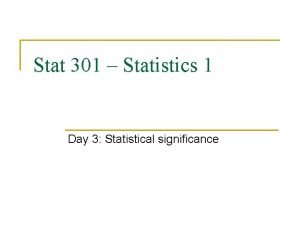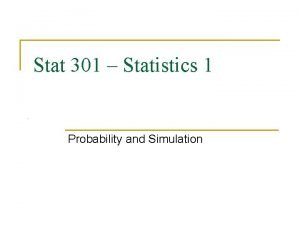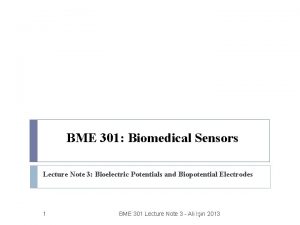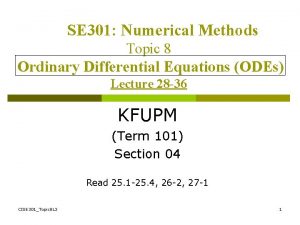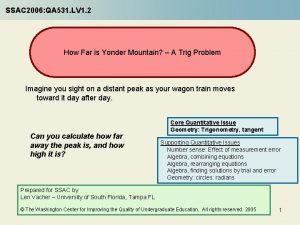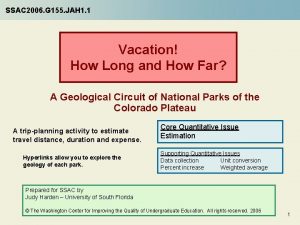SSAC 2006 QP 301 LS 1 2 What

















- Slides: 17

SSAC 2006: QP 301. LS 1. 2 What is your ideal body weight? What changes to your diet or exercise patterns must you make, and for how long, in order to achieve it? A Healthier You Modeling Healthier Weight from Dietary Improvement and Exercise Core Quantitative Issue Forward modeling Supporting Quantitative Issues Algebra – rearranging an equation Unit conversions Rate of change Multivariable function Visualization – bar graph Prepared for SSAC by Loretta Sharma, MD – Delta College, University Center, MI © The Washington Center for Improving the Quality of Undergraduate Education. All rights reserved. 2006 1 Version 10/04/06

Overview Excess adipose tissue on the human body has been linked to numerous health problems. 1 Deficiency in adipose tissue, while less common amongst Americans, is also linked to various health problems. 2 Fat stores on the body may be viewed as a balance between energy (caloric) intake, and energy expenditure (activity level). As a result, diet and exercise are two of the most important variables influencing the attainment, and maintenance, of healthy body weight. In this module, you will examine weight loss plans for individuals who seek to improve their body weight through diet alone, exercise alone, or combination therapy. Slide 3 Slides 4 and 5 Slide 6 Slide 7 and 8 Slide 9 Slide 10 Slide 11 Slide 12 Slides 13 and 14 Slides 15 and 16 Read the Problems Overview Subject Understand Strategy for Solving Problem 1 Create Spreadsheet to Solve Problem 1 Understand Strategy for Problem 2 Create Spreadsheet for Solving Problem 2 Understand Strategy for Solving Problem 3 Create Spreadsheet for Solving Problem 3 Graph Your Results End of Module Questions 2

Problem You are the healthcare advisor for a community-based weight loss class. Your goal is to help the participants achieve a healthy body weight by creating a plan for each of them to lose weight through healthful modification of diet, exercise habits, or both. PROBLEM: How long will it take each of your clients to lose her excess weight? Assume each client walks an extra hour per day. Second, suppose each replaces a poor food choice with a healthier one. Finally, consider what happens when your client improves both diet and exercise patterns, simultaneously, Mathematically, this is a modeling (or “What if? ”) problem. You are being asked to model what happens to body weight, a dependent variable, if one or both of two independent variables, diet and activity, are changed. One question you might have: How are we going to have numbers represent diet and exercise? The participants are all women in this class. You will be asked to work with an equation for men in the end-of-module assignments. 3

Background While there are numerous ways of evaluating adipose tissue, one of the simplest is to use Body Mass Index (BMI), which is a measure based on a person’s height and weight. The Centers for Disease Control and Prevention (CDC) define a healthy BMI for both men and women as being in the range of 18. 5 kg/m 2 to 24. 9 kg/m 2; values higher than this generally indicate overweight status, while values lower than this indicate underweight status. 3 The BMI model has some limitations, however, including failure to recognize individual differences in muscle mass or pattern of fat distribution. In this module, we will use the upper end of the recommended healthy (“normal”) range, which is a BMI of 24. 9 kg/m 2, in order to determine the minimum amount of weight each person should lose. However, in the long term, it may be best for each person to strive for achieving, and maintaining, a BMI nearer the middle of the healthy range (BMI of approximately 22 kg/m 2). 4

Determination of Healthy Body Weight How much weight, if any, does each participant need to lose? What information do you need to collect from each participant? One way to find the amount of weight each participant needs to lose is to compare the individual’s current weight to the individual’s healthy recommended weight, and determine the difference. This is the amount of weight each person needs to lose : Weight Loss Recommended = Current Weight – Recommended Weight. Current weight is easily determined, but how does one determine recommended weight? You will need to multiply a healthy BMI value of 24. 9 kg/m 2 by the square of the person’s height (in m) to find each individual’s goal weight, because Goal Weight (kg)/[Height (m)]2 = 24. 9 kg/m 2. This is algebra! Rearranging an equation. Therefore, you will need to collect information on the height and weight of all the participants in order to determine their current and goal BMIs. You need to record their sex and age too, because you will need to use these variables to calculate each person’s Resting Metabolic Rate (RMR). The RMR is the rate at which energy is burned at rest, and you will need it to complete your modeling calculation. 5

Strategy for determining the amount of weight each person needs to lose, using Excel spreadsheets: • Tabulate the information concerning the participants’ height and weight. • Convert height in inches and weight in pounds to height in meters and weight (actually mass) in kg, in order to use the BMI equation. These are problems in unit conversion. • Determine the goal weight for each participant, using BMI of 24. 9 kg/m 2 as a goal. • Find weight loss needed by each participant by subtracting goal weight from current weight. 6

Creating Your Spreadsheet Recreate this spreadsheet = cell with a number in it Be certain to include units in your labels at the top of each column! = cell with a formula in it Step 1: Click on Cell F 3, and enter the formula: =D 3*0. 0254 Step 2: Hit “Enter. ” Step 3: Move the curser over the bottom right corner of the cell, making a cross. Drag the cross down the length of the column and release. Unit Conversions: 1 in = 0. 0254 m 1 lb = 0. 454 kg Step 4: Create your own formula for Column G, by entering a formula in G 3 and dragging it down the column. 7

Expanding Your Spreadsheet Add three new columns to your spreadsheet. Use a BMI of 24. 9 kg/m 2 to calculate maximum ideal weight. In Excel formulas, division is indicated by a / symbol. Exponents are indicated by a ^ symbol. For example, F 3^2 means the value in Cell F 2 raised to the second power (1. 632 m 2, here). 8

Strategy for determining the number of days for your clients to achieve their healthy weights after modifying their activity level: • Determine the total reduction in kilocalories that is required for each participant. One pound of fat is equivalent to approximately 3500 Calories. • Determine the number of additional kilocalories required each day due to increase in activity level, using information relating to age, RMR, and METs. • Determine days to achieve weight loss, due to the increase in activity described above. Note: Remember that a Calorie (capital C) is different than a calorie (lower case c), as defined in physics. A calorie is the amount of energy required to raise a cubic centimeter of water by one degree Celsius. A Calorie is 1, 000 calories, or one kilocalorie. Although food labels often list “calories, ” they are actually reporting Calories. Definition: The Resting Metabolic Rate (RMR) is the rate at which a person burns energy at rest. (This is related to the more rigorous measurement of Basal Metabolic Rate. ) For the hypothetical sedentary female participants listed on this spreadsheet, the value can be approximated by the following adaptation of the Harris-Benedict formula, for sedentary females: RMR (Calories/hr) = [655 + (9. 6 × W) + (0. 0185 × H) – (4. 7 × A)] / 24 W = weight, in kgs H = height, in meters A = age, in years 9

Expanding Your Spreadsheet Add five new columns to your spreadsheet. • Column K calculates the Calories that are equivalent to the number of lbs to lose (Slide 9). • Column L applies the Harris-Benedict Equation for sedentary females (Slide 9). • Column M assumes that walking at 4 mph is 5 METs. One MET (Metabolic Equivalent Unit) represents the caloric consumption of an individual at rest and can be considered equivalent to the RMR. “For example a 2 -MET activity requires two times the metabolic energy of sitting quietly. ” The quotation is from the CDC site, http: //www. cdc. gov/nccdphp/dnpa/physical/pdf/PA_Intensity_table_2_1. pdf, which includes the METs for numerous activities in addition to brisk walking. • Column N is the excess of Column M over Column L. Column O makes use of the relation that the total calories expended is the rate at which they are expended times the time that they are expended at that rate (plus some algebra). 10

Strategy for determining the number of days for your clients to achieve a healthy weight after modification of diet alone, or after modification of both diet and activity level, using a spreadsheet: • Determine the daily reduction in Calories (kilocalories) due to the diet modification alone. • Determine the daily rate of weight loss due to the diet change plus exercise. • From the daily rate of weight loss, calculate the number of days to the desired total weight loss, both from diet change alone, and from diet change plus exercise. • Summarize the results of the calculation with a bar graph comparing the three options. 11

Expanding Your Spreadsheet Suppose Kelita chooses to eliminate her nightly 12 ounces (oz) of beer, Mary gives up 7 oz of red table wine per evening, and each of your other clients replaces a daily 12 oz regular cola with a 12 -oz diet cola. Add these three new columns to your spreadsheet. You can find the caloric value of various foods and beverages at: http: //www. pennhealth. com/health_info/weightloss/calories. pdf. For example, a 12 -oz beer is 138 Calories. 12

Looking at your results Here are the results for Kelita. To lose 10 lbs to reach her healthy weight, she can cut out a beer for 255 days, walk an hour a day for 170 days, or do both for 102 days. We can look at these results graphically 13

Looking at your results Recreate this spreadsheet including the bar graph. To make the bar grqph: • Highlight the column of categories and the column of times (Block B 7: C 9) • Open the Chart. Wizard. • Under “Standard Types, ” select “Column” and then the option with the simple columns (the first option). Hit “Next. ” • Hit “Next, ” again. • Enter a chart title and titles for your x and y axes. Don’t forget to indicate units!. Hit “Next. ” • Hit “Finish. ” • Right-click on the box “Series 1” and hit “Clear. ” 14

End of Module Questions 1. In this module, which had a more dramatic effect on weight loss: walking for an hour per day, or eliminating a beer from the diet each day? Did the results surprise you? Why or why not? 2. Suppose Cathy drinks four sodas a day, and she decides to replace all of them with diet sodas. How does that change her options? Create a spreadsheet including bar graphs that compares the three options discussed in this module for this diet change. 3. If a 23 -year old woman weighs 154 pounds and stands 5’ 2” tall, how much weight does she need to lose, in order to achieve a healthy normal body weight, according to the CDC? Answer the question with a spreadsheet. 4. The modified RMR formula used for sedentary males is: RMR (Calories/hour) = [66 + ( 13. 7 × W ) + ( 0. 05 × H) − ( 6. 8 × A)]/24 Using this formula, create and print an Excel table and graph for Jim B. , a 58 -year old man who stands 6’ 1” and weighs 289 pounds. Jim wants to begin walking five hours per week @ 4 mph, and he also wants to replace his daily lunch soda with black decaffeinated coffee. 15

End of Module Questions 5. Use Excel to answer the following question: How long would it take the woman in question 3 to achieve her healthy weight, if she added a half-hour of jogging at 6 mph per day to her routine, and replaced the 8 oz of whole milk she consumes each day with the same amount of skim milk? Use the Website links. 6. List all the variables that this module considered in determining healthy body weight. From your reading, personal research and class discussions, list the factors that were NOT considered in this model that would also have a significant influence on determination of healthy body weight. 7. What important benefits are conferred by exercise beyond those related to weight loss? 8. Revise the original spreadsheet so that the clients aim for the center of the BMI range rather than the upper limit. 9. For advanced spreadsheet users: Add “John” to the original spreadsheet. Add a column for the sex of the participants, with entries M and F. Use an IF function (see Help) to choose between the equation for men and the equation for women to calculate the value in the appropriate column. References: 1. http: //www. cdc. gov/nccdphp/dnpa/obesity/index. htm Go back 2. http: //www. nimh. nih. gov/Publicat/eatingdisorders. cfm Go back 3. http: //www. cdc. gov/nccdphp/dnpa/bmi/adult_BMI/about_adult_BMI. htm Go back The Title Page image used in this module is the property of the author, and was used with permission of the gentleman portrayed, Anton 16 Weisstein.

Pre-Test (You may use Excel or a hand calculator to answer questions 3 -6…or you can guess). 1. List the health risks of being overweight. 2. If a 42 -year old woman weighs 325 pounds, and stands 5’ 9” tall, how much weight does she need to lose, in order to achieve a healthy normal body weight, according to the CDC? 3. How long do you think would it take the woman in question 3 to achieve her healthy weight, if she added a half-hour of walking at 4 mph per day to her routine, and switched from drinking a can of cola to water, at lunch each day? 4. Name an alternative, specific regimen of alterations in diet and exercise that would allow the woman above to lose all of her excess weight in approximately one year. 17




